Healthcare is a fundamental human right, and ensuring equal access to quality healthcare services is a cornerstone of any just and equitable society. Unfortunately, in many parts of the world, women continue to face disparities in healthcare access and outcomes. This article delves into the issue of inadequate healthcare for women, with a specific focus on the disproportionate burden of maternal mortality and health issues that women endure.
Healthcare Disparities for Women
Women’s healthcare disparities are a multifaceted problem that encompasses a wide range of issues, from unequal access to healthcare resources to gender biases in medical research and treatment. These disparities manifest in various ways and at various stages of a woman’s life.
1. Maternal Mortality:
One of the most alarming disparities in women’s healthcare is the unacceptably high rates of maternal mortality in many parts of the world. Maternal mortality is a complex issue influenced by multiple factors, including inadequate access to prenatal and postnatal care, limited availability of skilled birth attendants, and socio-economic factors. In many low and middle-income countries, women face a significantly higher risk of dying during pregnancy or childbirth compared to their counterparts in high-income nations.
2. Limited Access to Family Planning:
A critical aspect of women’s health is the ability to control their reproductive choices. Inadequate healthcare for women in the form of access to family planning services and contraception can lead to unintended pregnancies, which may result in unsafe abortions or high-risk pregnancies, further contributing to maternal mortality and health complications.
3. Gender Bias in Medical Research:
The lack of gender diversity in medical research has led to a significant gap in our understanding of how diseases and treatments affect women differently. Historically, clinical trials have been predominantly conducted on male subjects, and results have often been assumed to apply to women without sufficient evidence. This gender bias can have serious consequences, as women may not receive treatments or medications tailored to their unique needs.
4. Gender Stereotypes and Stigmatization:
Gender stereotypes and societal norms can lead to the stigmatization of women seeking healthcare services, particularly in areas related to sexual and reproductive health. Such stigmatization can deter women from seeking the care they need, exacerbating health issues and complicating access to proper healthcare.
5. Lack of Education and Awareness:
In many regions, limited access to education and healthcare awareness programs prevents women from making informed choices about their health. Without the knowledge to recognize and address their health concerns, women may not seek medical attention until their conditions have progressed to a more severe stage.
Addressing Healthcare Disparities
Recognizing the existence of healthcare disparities for women is the first step towards addressing this critical issue. Several strategies can help bridge the gap and improve women’s access to healthcare and their health outcomes:
1. Universal Healthcare:
Ensuring universal healthcare coverage is essential for reducing healthcare disparities. When healthcare services are available to all, regardless of their socio-economic status, women are more likely to receive the necessary care during pregnancy, childbirth, and throughout their lives.
2. Promoting Gender Equity:
Promoting gender equity in medical research and treatment is imperative. This includes conducting more gender-diverse clinical trials, developing treatments tailored to women’s specific needs, and addressing implicit biases that may affect healthcare providers’ decisions and attitudes towards women patients.
3. Education and Awareness:
Raising awareness and providing education on women’s healthcare issues is crucial. Governments, non-governmental organizations, and healthcare providers can play a significant role in providing information and promoting healthy behaviours among women.
4. Strengthening Maternal and Reproductive Health Services:
Improving access to prenatal and postnatal care, skilled birth attendants, family planning services, and obstetric care is essential for reducing maternal mortality and improving women’s health. Investments in these areas can yield significant benefits for women and their families.
5. Challenging Stigmatization:
Efforts should be made to challenge and dismantle stigmatization surrounding women’s health. Open conversations, community engagement, and media campaigns can help reduce stigma and empower women to seek the healthcare they need.
Inadequate healthcare access and outcomes disproportionately affect women, particularly in the realms of maternal mortality and reproductive health. To address these disparities, a multi-pronged approach is necessary. Governments, healthcare organizations, and society at large must work together. Ensuring equal access to healthcare services, promoting gender equity in healthcare, and providing education and awareness programs for women’s health. It is only through concerted efforts that we can bridge the healthcare gap. Ultimately leading to healthier lives for women around the world and a more equitable society for all.




Leave a Reply